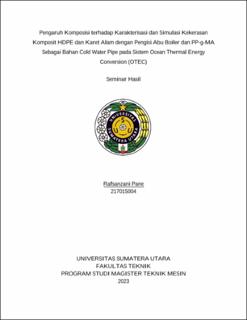| dc.description.abstract | Cold Sea Water Pipe (CSWP) in Ocean Thermal Energy Conversion (OTEC) power plant is one of the most important installation to transport cold sea water from sea bed (temperature 4o-6oC) and to condens working fluid (ammonia) vapour, which has been used to work on electric turbine in floating generator unit on sea surface. For OTEC design of 2 MW capacity, the required size of the CSWP is 4 m in diameter and 500 m in depth, and should be able to withstand against loads of continuous wave and sea current as well as hydrostatic pressure in a corrosive deep sea environments. Fibreglass-reinforced HDPE composites have been reportedly recommended as alternative materials for stainless steel, due to its good flexibility, low weight, corrosion resistant, thermal insulator, and cheap price. However, the composites required carefull manufacturing processes to achieve homogenous distribution without formation of voids and to protect the fibreglass fillers from damage. Palm oil mill boiler ash (POMBA) contains high content of silica besides mineral/metal oxides and can be utilized as fillers to reinforce HDPE composites in the presence of maleated-polypropylene (PPgMA) as adhesion promoter. On the other hand, natural rubber (NR) as one of the most abundance natural resouces in Indonesia functions to improve flexibility and toughness of HDPE/NR composites. In this works, the HDPE/NR/PPgMA/POMBA composites have been prepared using PAK200 Single Screw Extruder at 150oC, screw speed 100 rpm, POMBA loadings (0 – 40 php, per hundred part of polymer) at constant weight ratio of: HDPE/NR/PPgMA = 80/20/10. Specimens of the extruded composites were compression moulded at 180oC and maximum pressure and cut using CNC (computer numerical control laser cutting) according to ASTM D638. Characteristics of the composite samples were mesured including: tensile strength and compression strength tests, morphology of the fractures (SEM), spectroscopy (FTIR) and thermal properties (TG/DTA). Simulations of CSWP based on the HDPE/NR/PPgMA/POMBA composites againt hydrostatic pressure of deep sea of 500 depth were done using finite element methods of Ansys program. Results of the works showed that optimum condition was achieved when weight ratio composition of HDPE/NR/PPgMA/POMBA: 80/20/10/20 (php), with tensile strength of 19 MPa, and compression strength 20 MPa. Morphology of the fracture specimens revealed finely distributed and good adhesion of the POMBA fillers in the HDPE/NR matrices in the presence of PPgMA, as well as improved of thermal properties (increased decomposition temperatures and char/residue formations). Results of simulation studies of compression strength using finite elemen methods of Ansys program showed that the CSWP based on the HDPE/NR composites was able to withstand againt hydrostatic pressure of deep sea of 500 m depth. | en_US |


